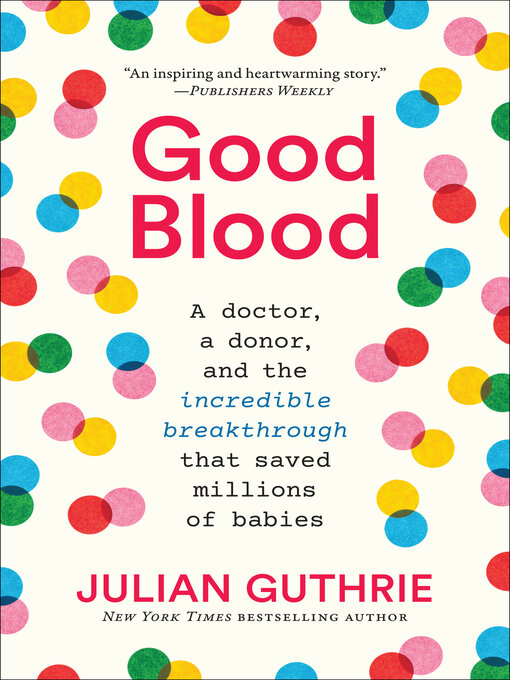Good Blood
A Doctor, a Donor, and the Incredible Breakthrough that Saved Millions of Babies
In 1951 in Sydney, Australia, a fourteen-year-old boy named James Harrison was near death when he received a transfusion of blood that saved his life. A few years later, and half a world away, a shy young doctor at Columbia University realized he was more comfortable in the lab than in the examination room. Neither could have imagined how their paths would cross, or how they would change the world.
In Good Blood, Julian Guthrie tells the gripping tale of the race to cure Rh disease, a horrible blood disease that caused a mother's immune system to attack her own unborn child. The story is anchored by two very di?erent men on two continents: Dr. John Gorman in New York, who would land on a brilliant yet contrarian idea, and an unassuming Australian whose almost magical blood—and his unyielding devotion to donating it—would save millions of lives.
Good Blood takes us from research laboratories to hospitals, and even into Sing Sing prison, where experimental blood trials were held. It is a tale of discovery and invention, the progress and pitfalls of medicine, and the everyday heroics that fundamentally changed the health of women and babies.
-
Creators
-
Publisher
-
Release date
March 31, 2022 -
Formats
-
Kindle Book
-
OverDrive Read
- ISBN: 9781647000158
-
EPUB ebook
- ISBN: 9781647000158
- File size: 3780 KB
-
-
Languages
- English
-
Reviews
-
Kirkus
July 15, 2020
A breathless history of a miraculous treatment. Journalist Guthrie begins by explaining that the "Rh factor" is a protein related to blood type. About 85% of humans have Rh protein in their red blood cells; 15% don't, making them Rh negative. If an Rh negative woman becomes pregnant by an Rh positive father, her fetus might be Rh positive. If so, the woman's immune system, which has never encountered Rh, treats it as a foreign invader and generates antibodies. This takes time, so the first child is not affected, but the mother becomes "sensitized"--her immune system attacks future Rh positive fetuses, killing them or producing devastating anemia in the newborn. Doctors prevent it with a simple injection, called RhoGAM, approved in 1968. Guthrie tells this genuinely uplifting story through biographies of two Australians. John Gorman came to the U.S. in 1955, trained as a pathologist, and began investigating Rh disease, which, at the time, killed 10,000 American babies every year. Reading studies, he learned that when a particular antibody is present in blood, it inhibits the immune system from attacking its target foreign protein. He wondered if simply giving Rh antibody to a woman would prevent her sensitization. He was right, and Guthrie delivers an expert account of the eight years of often frustrating research that proved it. The author's second hero is James Harrison, a bookkeeper who donated blood throughout his life, a total of 1,173 times. During lifesaving surgery as a teenager, he received many transfusions of Rh negative blood. Being positive himself, he developed titanic levels of Rh antibody, far more than the usual donor (RhoGAM is only obtained through donated blood). His blood has saved 2.4 million babies in Australia. Guthrie narrates her account like a novel, as her characters chat, think, brood, agonize, and ultimately triumph just as in a Hollywood movie. A readable pop-history account of medical research that turned out spectacularly.COPYRIGHT(2020) Kirkus Reviews, ALL RIGHTS RESERVED.
-
Publisher's Weekly
August 3, 2020
Journalist Guthrie (How to Make a Spaceship) chronicles the joint efforts of the Australian blood donor and the doctor who helped to solve the mystery of Rh disease in the 1960s. The illness occurs when a baby inherits the Rh antigen from its father and the mother’s blood is Rh negative. The mother’s antibodies destroy the baby’s red blood cells, causing anemia and miscarriage. Tens of thousands of babies succumbed to the disease each year until Australian doctor John Gorman, then a pathology resident at New York’s Columbia Presbyterian Hospital, and his colleagues had the idea to inject Rh-negative mothers, shortly before and after delivery, with a passive form of the same antibody they would naturally produce in reaction to their baby’s blood, in order to inhibit their immune response. Meanwhile, James Harrison, who had undergone a major chest surgery at age 14 that required a massive transfusion of blood, had been donating blood in Sydney for years. As a result of the transfusion, Harrison had developed 10 times more of the required antibodies than the average donor of his blood type, and his blood plasma soon became a key factor in the success of Gorman’s treatment. By donating his blood for more than 60 years, Guthrie writes, Harrison saved millions of lives. Though deep dives into technical matters may trip up lay readers, Guthrie vividly captures the determination and commitment of her two main subjects. This is an inspiring and heartwarming story of a medical breakthrough.
-
Formats
- Kindle Book
- OverDrive Read
- EPUB ebook
Languages
- English
Loading
Why is availability limited?
×Availability can change throughout the month based on the library's budget. You can still place a hold on the title, and your hold will be automatically filled as soon as the title is available again.
The Kindle Book format for this title is not supported on:
×Read-along ebook
×The OverDrive Read format of this ebook has professional narration that plays while you read in your browser. Learn more here.


